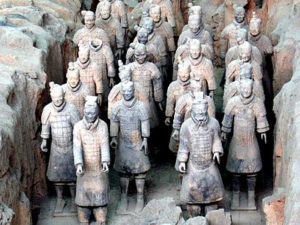 Earlier this week, the police in Philadelphia charged a man in his twenties with theft after apparently he broke off the thumb of a terra-cotta statue, valued at $4.5 million, at the Franklin Institute.
Earlier this week, the police in Philadelphia charged a man in his twenties with theft after apparently he broke off the thumb of a terra-cotta statue, valued at $4.5 million, at the Franklin Institute.
According to the authorities, the man was attending the museum’s after-hours ugly-sweater party on Dec. 21, entered the terra-cotta warrior exhibition room and used his cellphone’s flashlight to view the displays. Then, he put his arm around the statue and took a selfie. The authorities added that the man, later identified as Michael Rohana as reported by the New York Times, then went for a more permanent souvenir. He then grabbed the left hand of the statue, which is valued at $4.5 million, and broke off its thumb. Even though the investigation has taken several weeks, the man was charged last week in Philadelphia with theft of an artwork from a museum, concealment of the artwork and interstate transportation of stolen property. He was released on bail.
New York Times also reports that the FBI agents visited the man’s home and retrieved the finger from his desk’s drawer.
According to several reports, the news of the theft provoked anger in China, where the terra-cotta warriors are national treasures and a major tourist attraction. An official from the Shaanxi Cultural Heritage Promotion Center, which organizes the display of the statues abroad, asked that the thief be given a tough penalty. According to NYT, the Chinese officials offered to send two experts to the United States to repair the statue.
Since the incident the Franklin Institute has reviewed their security procedure and have stated that that a security contractor had not followed “standard closing procedures” the night of the party. Another group of terra-cotta warriors is now on display at the World Museum in Liverpool, England. The museum has reviewed procedures and told security guards that “any lapses are intolerable,” the Shaanxi Cultural Heritage Promotion Center official told the Beijing Youth Daily.
The statue of a cavalryman is one of 10 on display from Sept. 30 to March 4 at the Franklin Institute, along with other ancient artifacts including coins, gold pieces, jade and weapons. According to the historians, the terra-cotta warriors were built for the tomb of Qin Shi Huang, China’s first emperor. He united much of the country under the short-lived Qin dynasty, which is generally considered the origin of the name “China. Many of the statues are on display at the Mausoleum of the First Qin Emperor in Xi’an, China, where they are lined up in vast pits. Many others remain buried. The Xi’an museum and the statues were named a Unesco World Heritage site in 1987.















